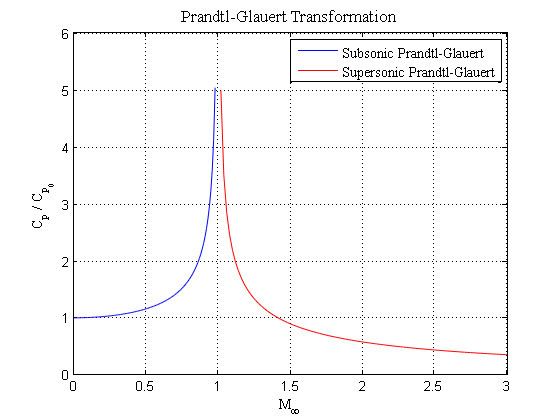 | ||
The Prandtl–Glauert transformation is a mathematical technique which allows solving certain compressible flow problems by incompressible-flow calculation methods. It also allows applying incompressible-flow data to compressible-flow cases.
Contents
Mathematical formulation
Inviscid compressible flow over slender bodies is governed by linearized compressible small-disturbance potential equation:
together with the small-disturbance flow-tangency boundary condition.
The above formulation is valid only if the small-disturbance approximation applies ,
and in addition that there is no transonic flow, approximately stated by the requirement that the local Mach number not exceed unity.
The Prandtl-Glauert (PG) transformation uses the Prandtl-Glauert Factor
The small-disturbance potential equation then transforms to the Laplace equation,
and the flow-tangency boundary condition retains the same form.
This is the incompressible potential-flow problem about the transformed geometry with surface normal vector components
which is known as Göthert's Rule
Results
For two-dimensional flow, the net result is that the
where
For three-dimensional flows, these simple
where AR is the wing's aspect ratio. Note that in the 2D case where AR → ∞ this reduces to the 2D case, since in incompressible 2D flow for a flat airfoil we have
Limitations
The PG transformation works well for all freestream Mach numbers up to 0.7 or so, or once transonic flow starts to appear.
History
Ludwig Prandtl had been teaching this transformation in his lectures for a while, however the first publication was in 1928 by Hermann Glauert. The introduction of this relation allowed the design of aircraft which were able to operate in higher subsonic speed areas. Originally all these results were developed for 2D flow. B.H. Göthert then pointed out that the geometry distortion of the PG transformation renders the simple 2D Prandtl Rule invalid for 3D, and properly stated the full 3D problem as described above.
The PG transformation was extended by Jakob Ackeret to supersonic-freestream flows. Like for the subsonic case, the supersonic case is valid only if there are no transonic effect, which requires that the body be slender and the freestream Mach is sufficiently far above unity.
Singularity
Near the sonic speed
